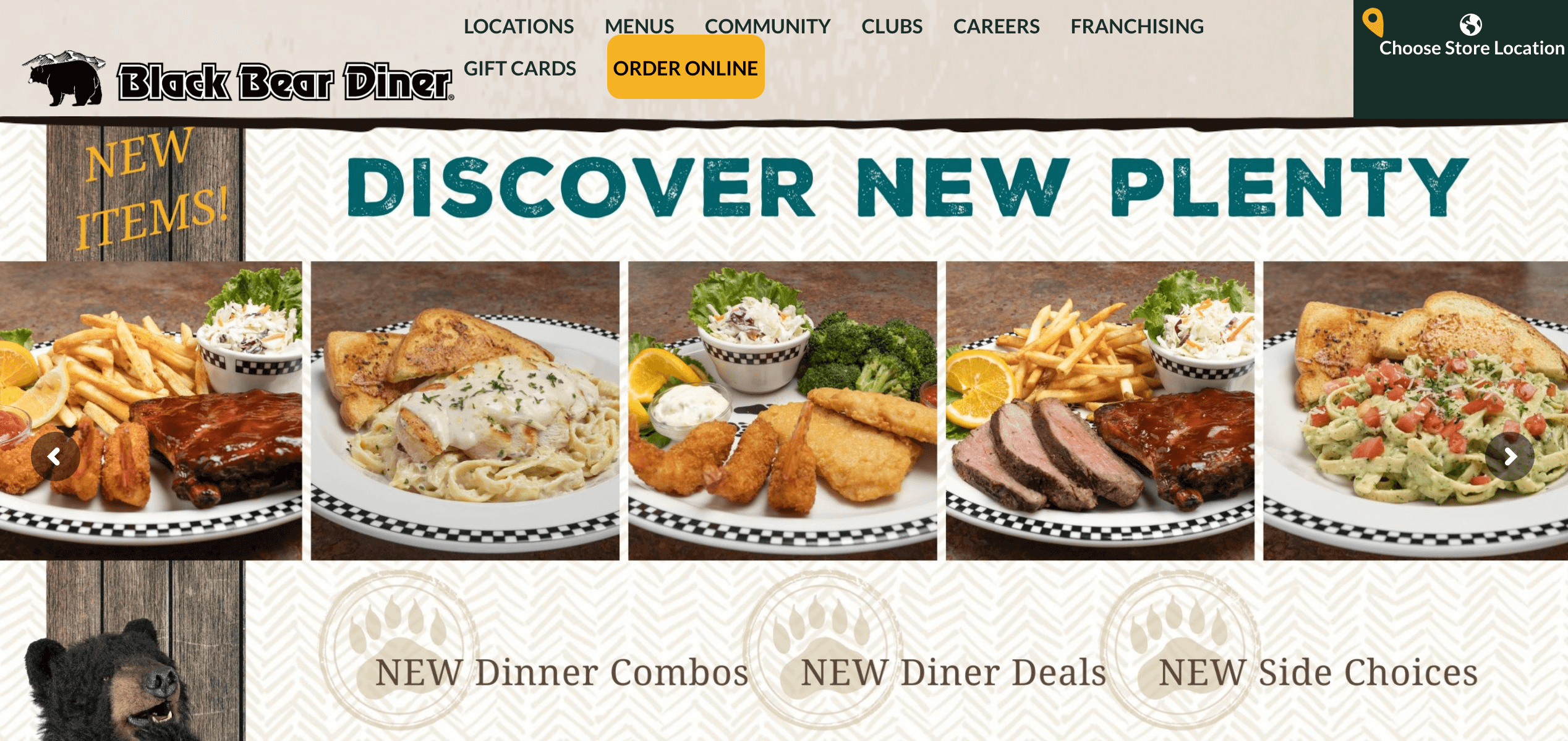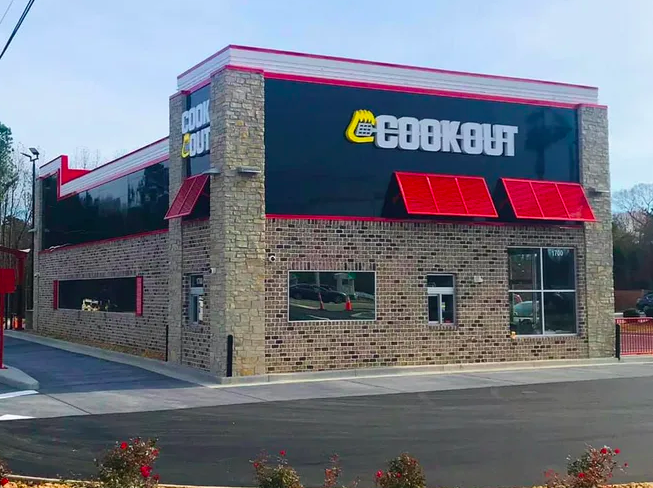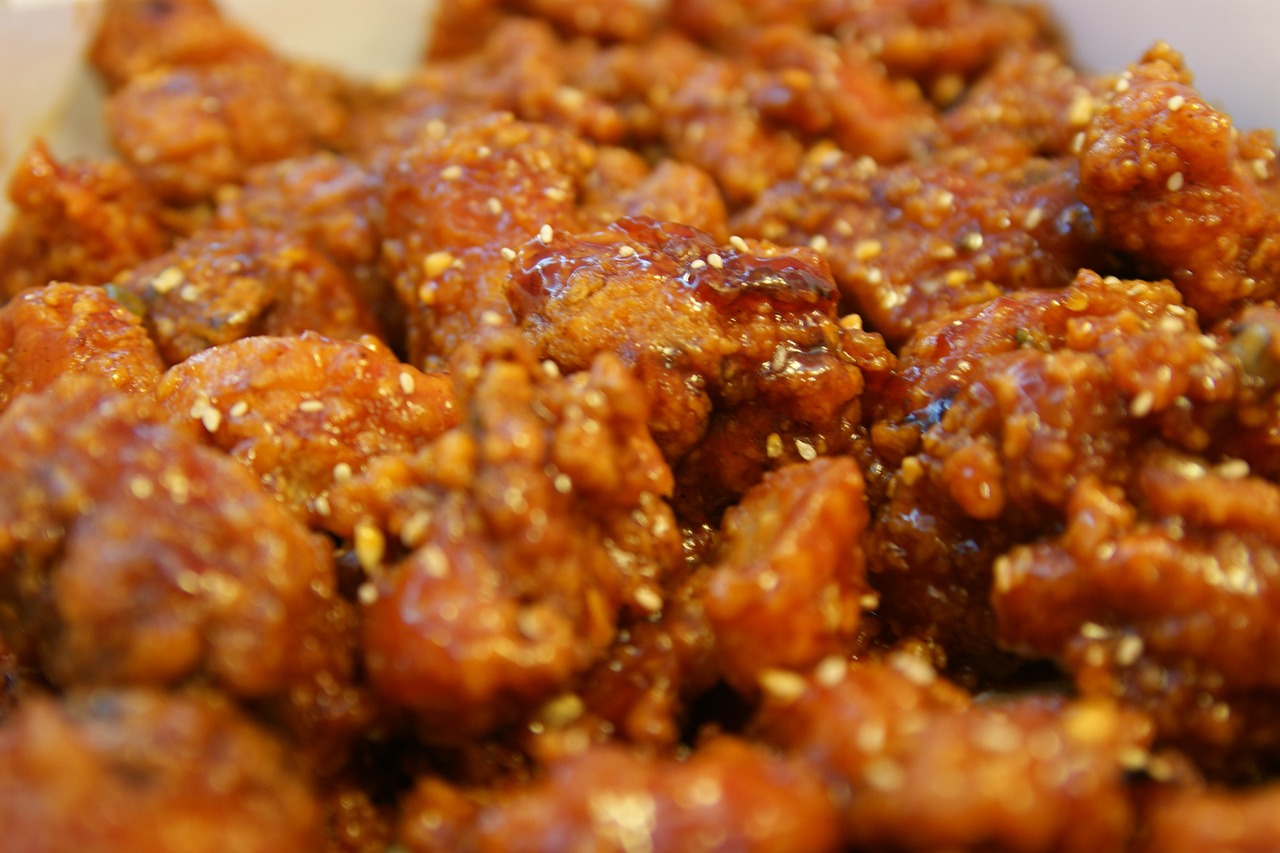This West Coast dining chain started as a small-scale restaurant with a bear motif and quickly grew to one of the significant restaurant players across 14 states. Founded by Bob Manley and Bruce Dean in 1995 this family restaurant began offering franchise opportunities around 2002 and now has over 144 restaurants operating in 14 states.
How much does it cost to open a Black Bear Diner? Opening a Black Bear Diner franchise requires a net worth of at least $1,500,000 before considering the franchise investments. On top of this, each restaurant starts with a $55,000 franchise fee and a sliding scale franchise fee for opening several restaurants in the same area.
The expenses don’t end there, however. There are several other costs to consider including marketing fees, grand opening costs, 4.5% of gross earnings, and other line items I’ll discuss later in this review. Opening a Black Bear Diner generally costs an estimated $1,114,800 to $1,876,200 with high-end estimates coming close to $3,000,000 mainly due to real estate costs.
Still interested in joining this bear’s den? Before starting your own Black Bear Diner, keep reading to learn more about this franchise and everything you need to know. Then, if you’re curious about what franchise best matches your style, take our 7-minute franchise quiz to be matched with an opportunity that fits your budget.
Page Contents
- Franchise Facts
- Financial Requirements and Fees
- Average Sales and Revenue Per Year
- How Much Profit Do Black Bear Diner Franchisees Make Per Year?
- Who Owns the Black Bear Diner Franchise?
- How Many Black Bear Diners Are There?
- What’s It Like to Work Inside Black Bear Diner?
- Advantages of Black Bear Diner
- Challenges of Black Bear Diner
- Is Opening a Black Bear Diner Right for You?
Franchise Facts
| Year Founded: | 1995 |
| Founders: | Bob Manley and Bruce Dean |
| Total Units: | 144, with 83 restaurants of the 144 as franchises |
| Industry: | Food and Beverage |
Founded in 1995 by Bob Manley and Bruce Dean, Black Bear Diner’s design reportedly came to the two business partners in a dream. Their first restaurant embraced the black bear and log cabin aesthetic and has grown into a multi-million dollar business with 144 units across 14 states.
The two co-owners were Northern California locals, where bears aren’t only found on the state flag. “Bears were a big part of my life,” Manley told Franchise Times. “I was a wilderness guide with bears. My sports team in high school was The Bears…Everything was based on bears…So I envisioned this restaurant with old-fashioned values, like the Cheers story, where everybody knows your name, and you’re actually a person.”
From a bare-bones start of $15,000 each, these two turned a single restaurant into a stunning family restaurant empire thanks to a rebranding change in the form of the family restaurant Jerry’s. These initial restaurants took off surprisingly fast. Today, Black Bear Diner is a favorite dining chain on the West Coast, with restaurants slowly creeping further East yearly.
Financial Requirements and Fees
| Fees and Expenses | Financial Amount |
| Liquid Capital | At least $100,000 to $150,000 for franchising, training, products, and amenities at a single location, not including real estate cost |
| Net Worth | $1,500,000 |
| Total Investment | Depending on the cost of real estate, total investment ranges between $1,114,800 to $1,876,200, with high-end estimates close to $3,000,000 |
| Initial Franchise Fee | $24,000 to $55,000 |
| Development Fee for Multiple Restaurants | 50% of the initial Franchise Fee |
| Royalty Fee | 4.5% of Gross Sales per week |
| Marketing Fund Contribution | 1.5% of Gross Sales per week |
| Local Advertising | 1.5% of Gross Sales per month |
| Grand Opening Advertising | $5,500 |
| Franchise Renewal Fee | $5,000 |
| Store Product Purchases | Varies |
| Merchant and Gift Card Processing Fees | Approx. $75/month plus 4.7% to 6% per transaction |
| Waitlist Management System | Approx. $35 to $45/month |
| Olo Online Digital Ordering System | Approx. $50/month, plus a monthly fee per order amount ranging from $5 to $90, and a commission payable amount of 20% to 30% of the order cost |
| Software Licenses Fees | Approx. $200 to $400/month |
| Employee Training Expenses | Varies |
| Substitute General Manager Training | $3,000 |
Other fees include penalties for not attending conventions, a $10,000 transfer fee if you decide to sell the restaurant to another owner, and additional hidden fees depending on inspections, product testing, and performance. Yikes!
Black Bear Diner will refund all but $10,000 of your initial franchise fee should they determine they do not want you to run a restaurant using their name. However, other than this caveat, the franchise fee is non refundable. Most Black Bear Diner franchise contracts are for ten years with renewals lasting another ten years. It is also worth noting you need at least 65 employees to operate a Black Bear Diner. Not always an easy task in a tight labor market.
Average Sales and Revenue Per Year
| Systemwide Annual Sales | $350,000,000 in 2021 |
| Average Annual Sales per Unit | N/A |
| Average Franchisee Profit | $2,574,759 |
How Much Profit Do Black Bear Diner Franchisees Make Per Year?
Estimating the average profit of a Black Bear Diner franchisee is challenging due to the COVID-19 pandemic and the ongoing recovery of the restaurant industry. However, some place the average franchisee profit at $2,574,759. Of course, this number should be taken with a grain of salt, as the low and high end of franchisee profits are not easily accessible.
Remember that a Black Bear Diner in an optimal location can result in significant revenue numbers. But location and experience operating / marketing a successful restaurant will play a big role in this success.
Who Owns the Black Bear Diner Franchise?
Co-founder Bruce Dean is currently one of the leading forces in charge of the Black Bear Diner franchise. While another co-founder Bob Manley has stepped down from running the restaurant, he is still involved on the company board.
In addition, CEO Anita Adams joined the company in 2019 following a successful track record as CFO of American Blue Ribbon Holdings (ABRH) and brought her experience to the franchise.
How Many Black Bear Diners Are There?
As of November 2022, there are 144 Black Bear Diners across 14 states. Of these 144 diners, a majority of them are located in California, where the chain got its start. Eighty-three of these restaurants are franchises, meaning the remaining 61 are company-owned.
During the COVID-19 pandemic, franchise numbers stayed relatively constant due to industry challenges. However, as a response to the struggles caused by the pandemic shutdown, Black Bear Diner moved to off-premise sales, increasing these to 20% instead of the previous portion of 7%.
This flexibility signals a company willing to improvise and experiment to constantly improve customer experience and ensure their franchisees have the tools necessary for success.
What’s It Like to Work Inside Black Bear Diner?
A review of former employee testimonies on sites like Glassdoor and other employment websites shows that while working at Black Bear Diner varies from location to location due to management, the overall impression of the company and CEO is positive.
Many employees complain about poor management. However, they appreciated the shift flexibility and availability and found the fast-paced atmosphere agreeable. Some complained about the expectations placed on low-level staff, meaning that franchise owners should balance their hires’ duties properly to ensure staff retention.
You Might Like: How Much Does the Roy Rodgers Franchise Cost with Fees?
The Black Bear Diner work structure is similar to any other Americana restaurant, with a standard diner fare menu and rotating menus covering breakfast, lunch, and dinner. Employees are expected to work in the kitchen preparing food, as servers or hosts, or as cleaning staff and management. In general, training in proper management positions can help balance the workload of a franchise owner and improve the overall workplace satisfaction of all employees. In addition, encouraging communication between work areas and promoting a professional, courteous environment can go a long way toward employee retention and customer satisfaction.
Remember that the average Black Bear Diner requires at least 65 employees to function, with added employees needed for sick time coverage, vacations, and during the seasonal rush. In addition, black Bear Diner provides training information for new hires and management positions, so be prepared to finance this training when starting your restaurant.
Advantages of Black Bear Diner
Some advantages of opening a Black Bear Diner include the ease of start-up, the established nature of the business, and the overall popularity of the restaurant. Since its founding 27 years ago, Black Bear Diner has grown each year significantly and now includes 144 restaurants across 14 states. The reliable menu and classic comfort food are easy to prepare and require little in the way of specialized ingredients.
In general, while the start-up cost of a Black Bear Diner is steeper than other franchise restaurants, the average franchisee profit matches the initial start-up cost, meaning that some franchisees see a return on investment in total in their first fiscal year. In addition, due to the age and popularity of the franchise and its performance during complicated COVID-19 restrictions and general restaurant revenue slump, this restaurant is a generally sound investment for an American-style diner franchise.
Challenges of Black Bear Diner
The high start-up cost of this franchise can be an immediate barrier to investment. While the franchise fees are relatively reasonable, especially with the sliding scale for multiple restaurant investments, the cost of real estate, training, general gross profit fees, licensing fees, and product investments can be daunting for potential franchisees.
While the company has been consistent in its growth over the years, the various “hidden fees” that come on top of the franchise fee can be a downside for potential investors. For example, not only are franchisees expected to fund aspects of employee training, but failure to attend certain company functions can incur a fine. In addition, depending on state and local limits, late payment fees come with an 18% interest fee. These fees may lessen the overall franchisee profits if your restaurant runs into a slow period, and you may lose profits quickly should you routinely fall behind.
You Might Like: How Much Does it Really Cost to Open a Ruth’s Chris Franchise?
Another thing to consider is that while Black Bear Diner has been slowly making its way across the United States, it is securely a West Coast chain, meaning it may not be an excellent investment for someone looking to open an East Coast restaurant. While this may be a chance to be the only Black Bear Diner in an area, the struggles of trying to bring a new franchise to an established site are usually not for the faint of heart.
To summarize, steep start-up costs, local popularity, overall investment costs, and potential late fees all contribute to the challenges of this restaurant. Another thing to consider is the number of employees needed to run each restaurant.
With a minimum of 65 employees recommended per location, starting up a Black Bear Diner is not for beginners and requires significant management experience. Not only that but training new managers can become costly due to the $3,000 training fee, meaning managing such a large team of employees can quickly become an issue.
In general, Black Bear Diner is not a beginner franchising opportunity. While the restaurant business plan is straightforward, and there is a significant amount of popularity and brand recognition behind the chain, the start-up costs, management experience needed, and overall size of a single restaurant make this restaurant an experienced franchisee choice.
Is Opening a Black Bear Diner Right for You?
In general, not every opportunity works for every investor. Before diving into a Black Bear Diner franchise restaurant, taking stock of your finances is essential. The company reserves the right to refuse any franchise application, meaning that you’re unlikely to be approved to open the restaurant if you do not make the minimum net worth.
Thanks to the multi-restaurant discounts, opening and running several Black Bear Diners in the same area can be a viable strategy. They may prove a challenging but rewarding investment opportunity for the wise entrepreneur.
Of course, before starting any franchise or branding opportunity, talk with other franchise owners in the same industry to find out any hidden costs, challenges, or fees that may come hand-in-hand with the business opportunity. Make a realistic assessment of your initial investment, and take the time to compare real estate costs, kitchen supplies, and employee training fees before fully committing to a 10-year franchise contract.
If you are interested in discovering other franchise opportunities, check out our other articles. We cover franchises in various fields, from food and beverage to finance and taxes. Finally, if you’re unsure where to begin, take our seven-minute franchise quiz to find out what kind of franchise is the right fit.





